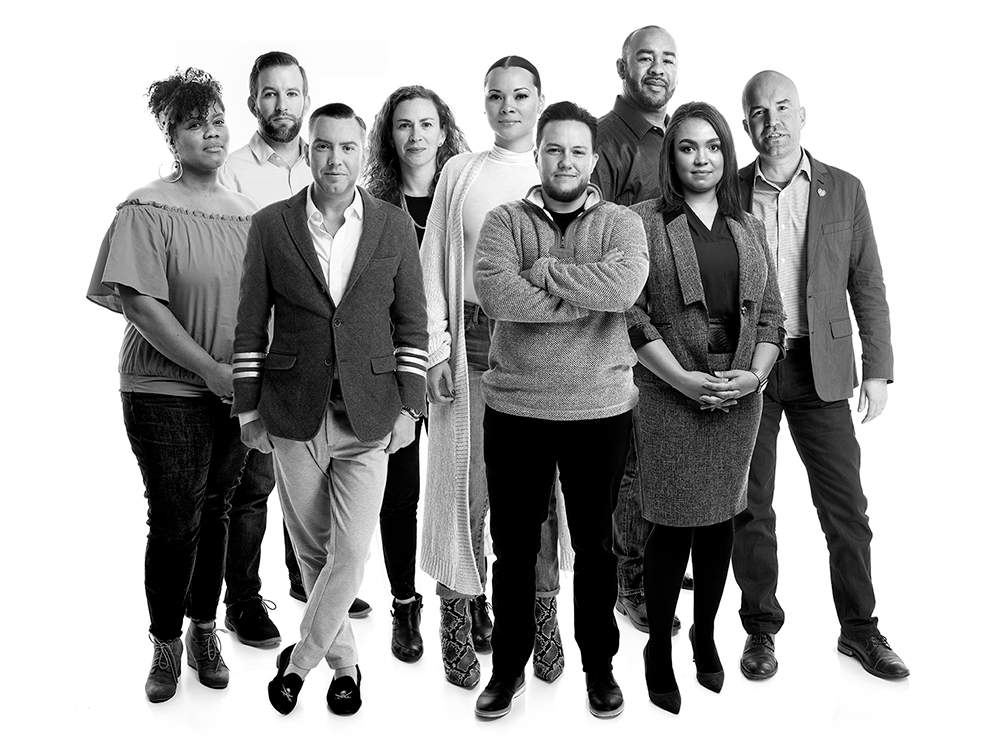
Nine Kansas Citians of varying race, gender identity, religion, and professions have more in common than just regional geography.
They’re each passionate about giving back to their communities.
For members of today’s younger demographics, including millennials and Gen X-ers, philanthropy is less about writing large checks than it is about making another kind of payment: paying it forward.
From serving on non-profit boards of directors and starting events or organizations to lobbying at the state capital and conducting mission work on the other side of the world, this group of dedicated community advocates shows just how many ways there are to make not just your surrounding community, but also the world a better place.
Here, they share what drives them, how they give back, what they’ve learned and why community service is more than a hobby—it’s a calling, one that everyone should answer.
Why Give Back?
Familial influence, meeting new people, helping others, personal and professional growth—what motivates this group of people to give back to their communities is as wide-ranging as the opportunities themselves.
For Gene Willis, the chief engagement officer at United Inner City Services, it was the simple yet impactful words of renowned philanthropist and Kansas Citian, Ewing Kauffman, that helped spark his interest in service.
“I earned a college scholarship through the Kauffman Foundation, and the thing that Mr. Kauffman said was ‘Give back and do well,’” Willis says. “When someone makes that kind of impact on your life and invests in me over the long term, giving back or paying it forward is the least I can do to ensure this cycle of growth continues in our community.”
Tekia Thompson, the gleaning and outreach coordinator at After the Harvest KC and an assistant manager at Ten Thousand Villages; Lynn Hoffman Carlton, the regional director of planning for HOK; and Jake Jacobson, the vice president at Native Digital, are among those encouraged to follow in their parents’ footsteps and prioritize community involvement.
“My mother is a powerhouse,” Thompson says. “She empowered me to be someone who does something in the world instead of just walking through it, not seeing what’s around you or making a difference.”
Adds Jacobson, “Looking for ways to help is something my parents forged into my mind, especially if it’s something you enjoy doing.”
Hoffman Carlton, whose parents taught her the importance of giving back, is now sharing those lessons with her two sons, Griffin and Bridger. “On Martin Luther King Jr. Day, my husband and our kids did a day of service,” she says. “I want to make sure they understand the value and benefits of volunteering.”
That’s another trait these civic-minded Kansas Citians share—a true enjoyment of helping others and an excitement about what’s collectively possible.
“It would be great if we could all make $50,000 donations to the organizations we support, but that’s not a reality for most of us,” says Mike Mitchell, director of sales for asphalt manufacturer Vance Brothers. “That doesn’t mean there’s a lack of desire to want to be involved in the community and wanting to help. There’s so much good stuff going on in Kansas City at a micro level.”
An Opportunity for Every Interest
According to Nonprofit Connect’s 2019 annual report, the KC metro is home to nearly 9,000 501(c)(3) organizations. That doesn’t include groups that aren’t formally organized or individual opportunities to give back.
In short? Whatever cause you’re passionate about, there’s likely a group—or at least a few people—working toward the same goal.
That’s a big reason why all of the story participants agreed that an important first step to community involvement is identifying the groups and/or causes that are exciting or meaningful to you.
“My areas of interest are arts, education, and kids,” Hoffman Carlton says.
Amy Guerich, a partner at financial planning firm Stepp & Rothwell, says her alma mater, Kansas State University, and the arts are the two things she “cares about the most.”
Thompson says solving hunger is one of her top priorities—specifically, “providing healthy food and access to healthy food to those communities without,” she says. “We waste nearly 50 percent (or more) of our food. I know there are several organizations in Kansas City working to make a difference, but I think we’re missing a huge opportunity to grow more good food and feed more people in our community.”
There’s no doubt that the range of available volunteer opportunities is a key driver when it comes to encouraging people to get involved. And here’s the best part: when you’re helping others, no role or task is too small.
“When I first moved to Kansas City, I got involved with the Arthritis Foundation and, each December, would help direct parking lot traffic before their annual race event,” Jacobson says. “It’s not exactly a sexy volunteer role, but attendees would talk about how nice it is to be greeted with a smile and reassured that they’d get to the start line on time.”
So many non-profit organizations run on skeleton teams that opportunities often exist for advocates to donate resources besides money; namely, time and talent.
“I’m not swimming in money, but what I have to give is my time and my network and lending what I hope is my good name to different organizations,” says McClain Bryant Macklin, the director of policy and research for the City of Kansas City. “I also offer knowledge capital and helping organizations to think through how to be more inclusive, how to be more attractive to younger audiences and how to be more socially conscious.”
Start From Scratch
Despite the number of available volunteer opportunities and non-profit groups, gaps still exist. That’s one reason why more people are embracing an entrepreneurial spirit when it comes to their community involvement, starting events or organizations at the ground level to help others in ways they never imagined.
Mitchell had an idea one night while sharing a glass of wine with his wife. Mitchell had been a longtime advocate for the Gillis Center, now part of the larger Cornerstones of Care network. “The work they do with families and kids that have been exposed to trauma is unreal and the whole metro benefits,” he says.
While talking with his wife, Mitchell wondered why people don’t often go caroling anymore. Then, the idea grew. “We turned caroling into a way to collect donations for the Cornerstones of Care gift gallery,” he says. “If anybody answers their door when we stop by, we tell them that we’re raising awareness while collecting donations.”
Mitchell turned to the ultimate 21st century conversation starter—Twitter—to spread the word about the inaugural Tipsy Caroling event. Last year, Mitchell hosted the second annual event and, at his wife’s urging, became better organized! “She made fliers that I printed off and distributed around the neighborhood the week before the event,” he says. “They gave information about what time we’d be caroling and that we’re collecting donations. We had quite a few houses welcome us and give us money or gifts.”
Willis is a two-time Tipsy Caroling participant, having been introduced to Mitchell through Willis’s weekly Gene’s Five Questions Twitter chat (search #G5QS on Twitter to see past conversations).
Willis launched #G5QS in 2011 to help bring people together online in a positive way. “It’s an opportunity in the midst of the vitriol that we see on social media to create an environment where people can connect in the most trivial of ways, but also in the most profound ways,” he says.
The premise is simple: every Tuesday night between 8:30 and 9 p.m., Willis asks five questions on Twitter, each labeled with the hashtag #G5QS. Then, he watches the responses roll in, sharing them and engaging with participants. He writes most of the questions, but also crowdsources ideas and occasional guest hosts. “It trends almost every Tuesday night when we do it, and the ‘we’ is the big part,” he says. “I think it’s a reminder that connecting can be fun.”
It was #G5QS that sparked Willis and Mitchell’s friendship. Now, Willis says they’re friends that not only support each other’s endeavors—Tipsy Caroling and United Inner City Services—but also talk about everything “from the Royals to religion,” Willis says.
Like Willis, Drew Smith felt driven to build a community where he previously saw none. Smith, an IT Specialist at Lathrop GPM, began transitioning from female to male in 2010 and realized he was in dire need of support. “I didn’t know what transgender was until I found something on YouTube,” he says. “That’s where a transgender community existed, but I wanted to connect with people locally.”
Through word-of-mouth, Smith gathered five transitioning men in the small Midtown studio apartment he shared with his girlfriend (now wife). “We were in awe of each other and couldn’t believe that we all were transitioning,” he says.
“You’re reaching people, building relationships, filling specific needs and experiences. You don’t realize how many local opportunities there are to get on that human level with someone.”
— Drew Smith
Those impromptu meet-ups became an official organization, The Union — A Midwest Transguy Coterie, which has now built an online community of more than 250 members. In addition to providing a safe space for transgender males to ask questions and learn, The Union also hosts programming, including Momentum, a partnership with Waldo-based City Gym that helps members focus on their health and fitness.
Smith also teams up with local professionals to host events in another sub-group of The Union, Union Jack. During the informal gatherings, guest attendees will showcase a particular skill—how to tie a tie, for example—that The Union members may have not previously learned during a female-oriented upbringing. “I feel like volunteering today is a fuller experience,” Smith says. “You’re reaching people, building relationships, filling specific needs and experiences. You don’t realize how many local opportunities there are to get on that human level with someone.”
Lessons Learned
At its core, volunteering is about helping others. Yet there’s no doubt that anyone who volunteers is just as positively impacted by the experience.
Fred Rogers—quite possibly the ultimate example of doing good—made the world collectively teary-eyed when, in the wake Robert Kennedy’s assassination, he offered this advice: “My mother would say to me, ‘Look for the helpers. You will always find people who are helping.’”
That drive to help hasn’t only guided Jacobson’s community involvement; it’s the common thread in his professional roles, too. And it also guides how he cultivates and cares for his network, which often reveals more opportunities to give back.
“It’s important to treat your network like a friendship and relationship, not as a transactional exchange,” he says. “If I wait to talk to you until you can help me, why would you help me? People jokingly give me a hard time about having a big network, but I don’t see it that way. I see it as having a lot of friends.”
Guerich, who has held a number of Board of Director positions, credits her community involvement with playing a chief role in her professional development. “The only reason I’ve been able to assume these management roles in my company is because I’ve been serving on boards since I was 24,” she says. “People really underestimate how important that experience is—it’s leadership.”
Guerich has also built relationships with a group of women who range in ages from 36 to 65. They meet regularly to share stories, ask for advice and simply enjoy each other’s company. “These are some of my dearest friends, and I met them all through board roles and service,” Guerich says.
And there’s nothing like giving back to help you embrace the bright side of life.
“I’ve gradually discovered that being part of something larger than myself is a great exercise in humility.”
— Damian Lair
“My wife, Carrie Dilley, and I have been foster parents for Great Plains SPCA for nearly six years,” Willis says. “We’ve fostered 23 dogs, many of which have come from the streets, hoarding situations, or abuse. We had one dog for seven months that we didn’t think someone would want; she was so shy and fearful. We met someone who wanted a dog exactly like her, and I realized that there truly is a lid for every pot.”
That saying applies to volunteer opportunities, too. Whatever skill or interest someone has, there’s likely a group or event that meets that particular need. Damian Lair, co-founder and managing director of a public affairs consulting firm, for example, focuses his community involvement on arts-related organizations, which helps him give back while also providing him an otherwise lacking creative outlet.
“You can volunteer in a way that uses your professional skills, or you can volunteer in a completely opposite direction from your profession to give yourself more dimension as a person,” he says. “We all have limited time, and you should be getting something out of these experiences. There’s growing, learning, discovering and the engaging that comes along with giving your time and resources. I’ve gradually discovered that being part of something larger than myself is a great exercise in humility.”
Your Turn
Ready to make a positive impact in your community? Our panel of all-star volunteers shared a few tips to help you get started.
Identify your interests.
“Figure out what causes or organizations are important to you,” Mike Mitchell says. The world is so small today that we can find someone who has a similar concern or similar values, and my guess is they’re willing to help you get involved.”
Schedule your commitments.
“It’s about being smart with your time,” says Lynn Hoffman Carlton. “I work with Lead to Read over my lunch hour and mark it on my calendar like it’s a meeting.”
Ask your friends.
“Don’t sit around and wait for someone to ask you to be involved,” Damian Lair says. “Everyone has a friend who’s involved with something, and that’s a great place to start.”
Don’t overlook municipal government.
“Most people don’t appreciate how important our local government is,” says McClain Bryant Macklin. “They’re in the best position to be the most responsive to everyday needs. Go to city or neighborhood meetings and stay in touch with your elected officials through phone calls or letters. It’s incumbent of us to stay abreast of what’s going on. Channel 2 is another important resource.”


